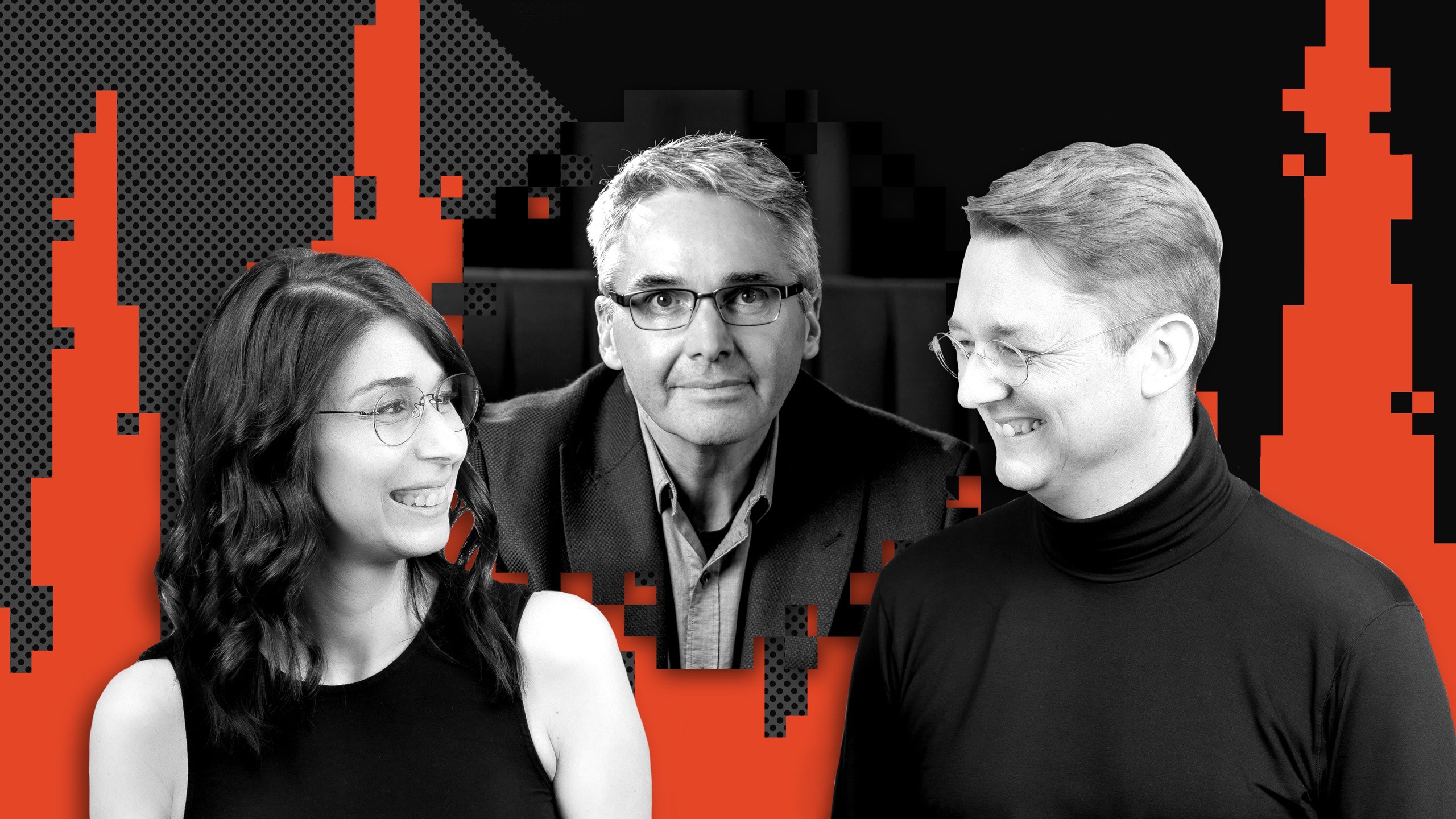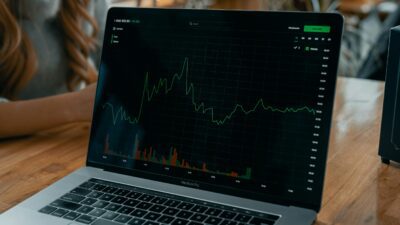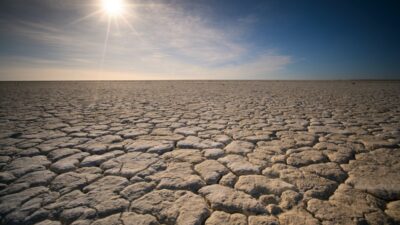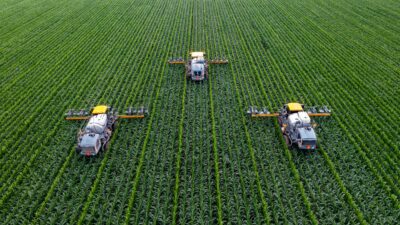Sandra Peter, Kai Riemer and Christopher Wright

The numbers of climate change and COP26 on The Future, This Week
This week: all the numbers of climate change and what they mean from the COP26 in Glasgow, with our expert Professor Christopher Wright.
Sandra Peter (Sydney Business Insights) and Kai Riemer (Digital Futures Research Group) meet once a week to put their own spin on news that is impacting the future of business in The Future, This Week.
Our guest this week
Christopher’s blog: Climate, People & Organizations
Christopher’s recent article on the IPCC report
Christopher’s article with Michael E. Mann about COP26
Christopher’s book chapter on fossil fuel industry and climate crisis
The stories this week
02:28 – the UN Climate Change Conference (COP26)
The numbers this week
415ppm – the atmospheric concentrations of carbon dioxide
1.5ºC – the target from the 2015 Paris Agreement
60th – the ranking given to Australia’s climate policy in the Climate Change Performance Index
Other stories we bring up
Our previous discussion with Christopher on climate action and apocalypse
Climate jargon explained by the New York Times Climate Desk
BBC’s four numbers to remember for COP26
The world’s biggest carbon-removal plant just opened
How to remove carbon from the atmosphere
Our previous discussion of the IPCC report on The Future, This Week
2.4ºC estimate from COP26 national commitments
1 billion people will suffer extreme heat at just 2ºC heating
An inside look at the talks happening in Glasgow
Climate pledges from several countries are built on flawed data
The previous promises of climate finance
The numbers of the coal industry in Australia
Humorous take on COP26 from Juice Media
NASA climate change data page (lots of numbers!)
Follow the show on Apple Podcasts, Spotify, Overcast, Google Podcasts, Pocket Casts or wherever you get your podcasts. You can follow Sydney Business Insights on Flipboard, LinkedIn, Twitter and WeChat to keep updated with our latest insights.
Send us your news ideas to sbi@sydney.edu.au.
Music by Cinephonix.
Dr Sandra Peter is the Director of Sydney Executive Plus at the University of Sydney Business School. Her research and practice focuses on engaging with the future in productive ways, and the impact of emerging technologies on business and society.
Kai Riemer is Professor of Information Technology and Organisation, and Director of Sydney Executive Plus at the University of Sydney Business School. Kai's research interest is in Disruptive Technologies, Enterprise Social Media, Virtual Work, Collaborative Technologies and the Philosophy of Technology.
Christopher Wright is Professor of Organisational Studies and leader of the Balanced Enterprise Research Network at the University of Sydney Business School. His research focuses on the diffusion of management knowledge, consultancy and organisational change.
Share
We believe in open and honest access to knowledge. We use a Creative Commons Attribution NoDerivatives licence for our articles and podcasts, so you can republish them for free, online or in print.
Transcript
Disclaimer We'd like to advise that the following program may contain real news, occasional philosophy and ideas that may offend some listeners.
Kai So, what should we talk about on this day of horrendous rain here in Sydney?
Sandra Yes, it's very apocalyptic out there. But we are back in the studio, and we've had a few fantasy based episodes in the last few weeks, we spoke about the metaverse, we covered Squid Game.
Kai The metaverse, yes. Fantasy-based, technology, yeah.
Sandra I think it's time to bring it very sharply back to reality. And there's one big news for the future of business and humanity more generally.
Kai There is Glasgow, the COP26 summit.
Sandra The 26th conference of the almost 200 countries that have been coming together for quite a while now, including back in Paris in 2015, to try to agree on a way forward.
Kai And this year they meet in Glasgow, to basically outline how the climate crisis can be tackled, and what countries will do to curb the worst effects of climate change. We must say now, because I think there's growing consensus not only that climate change exists, but that we have already reached tipping points at which you know, there's no return.
Sandra We've been following what's going on at the conference, and we've been discussing various numbers that have appeared, you know.
Kai Anything from zero to a trillion.
Sandra Yes.
Kai Lots of numbers being bandied around.
Sandra Lots of numbers of temperatures, of concentrations, of investments, of targets, of damages, of people affected and so on. And as we try to make sense of all of this, we thought we need help on this one.
Kai We need an expert.
Sandra So Chris Wright it is.
Kai Our own University of Sydney Business School's expert on the topic.
Chris Wright I'm Chris Wright. I'm a professor of Organisation Studies in The University of Sydney Business School and also a key researcher at the Sydney Environment Institute.
Sandra So let's call him.
Kai Yes, let's do this.
Intro From The University of Sydney Business School, this is Sydney Business Insights, an initiative that explores the future of business. And you're listening to The Future, This Week, where Sandra Peter and Kai Riemer sit down every week to rethink and unlearn trends in technology and business. They discuss the news of the week, question the obvious and explore the weird and the wonderful.
Sandra We really wanted someone who can tell us a little bit more about these numbers that we're struggling to make sense of all around Glasgow and COP26.
Chris Wright Yeah, well I mean climate's everywhere now, isn't it? It's in the news. It's everywhere you look with the COP happening in Glasgow. And it's about time that happened, of course, because one of the problems of climate change for the last 20 or 30 years is nobody wants to really talk about it. So it's sort of like the elephant in the room given the pretty catastrophic implications it poses for the future of humanity and life on the planet and all that stuff.
Sandra You've been talking about it, maybe not for quite that long, but you've been talking about it. And you know, you're in the business school, you're in Strategy, Innovation and Entrepreneurship, but you've been interested in this issue for quite a while and researching it.
Chris Wright Yeah. Well, it's kind of frightening how long it's been because time flies, but I started getting interested in this in the early 2000s when I was at UNSW. And then the Stern report came out in the UK in 2006, the Al Gore movie came out 2007, An Inconvenient Truth. And I started to get interested in climate change in a research capacity because it struck me there were clearly big business implications in the space. And really, since about 2007, 2008, I've been doing research on climate change, and business and how businesses contribute to the climate crisis. Now, some businesses and some industries are engaged in trying to sort of mitigate their emissions and adapt climate change. So everything to do with the political economy of climate change in businesses, where I've become increasingly obsessed.
Sandra We've come to this point, right, the almost 200 parties that were there for the Paris Agreement in 2015, have now come to Glasgow with the aim again of reaching some long-term goals towards net zero emissions around the middle of this century, and some kind of shorter-term national plans. And they've been so many numbers put forward that all seem to matter for our collective futures and our collective business futures. So we thought we will clarify a few and the three of us have had a chat and are going to try to each put forward a number.
Kai Yeah, and because you're the guest today, Chris, I think we'll let you go first.
Chris Wright Okay, all right. Well, I'm going to nominate 415, and that number is a reference to the concentrations, the atmospheric concentrations of carbon dioxide, so it's 415 parts per million approximately is where we're at this year. It varies each summer, northern hemisphere, summer and winter because, as you may know in the Northern Hemisphere, the trees all leaf up and they absorb carbon. So the emissions go down a little bit, and then they bang back up again in the northern hemisphere winter. But the longer story is that that is the number we should all be focused on, not the net zero, not all the other stuff because the atmosphere doesn't, well the climate doesn't really care about our political activities. It only cares about the concentrations of greenhouse gases in the atmosphere. That's what generates global warming, and all the other impacts that flow from that. And pre the Industrial Revolution, pre sort of late 1700s, 1850, the concentration was at 280 parts per million. We're now at around 415. And it's going up. And for 30 years of climate negotiations, we basically haven't changed that trajectory, that metric, it continues to increase.
Kai How much does it increase by every year?
Chris Wright Well, I can think back, we breached 400 parts per million in 2015. So that gives you an idea of how rapid the increase is. So it's ticking up almost, if you look at the Oceanographic Institute graph on this, it's like a 45-degree line, it zigzags, it's a 45-degree line up. So it's, it's continuing a steady and remorseless increase. And we actually to get to a stable climate, we need to get back to 350 parts per million, which is another nice number 350, because that's the name of the environmental NGO, 350.org, led by Bill McKibben, which has led the whole sort of movement towards fossil fuel divestment. So if we want a stable climate, we need to get back down to 350. If anything, we just continue to increase. So 415 is my number.
Kai So 415 is where we're at.
Chris Wright Yeah.
Kai 350 is where we should be.
Chris Wright Yep.
Kai But we hear a lot about net zero. And I think, you know, that, that sounds like such a great number, zero, everyone wants to just go to zero. But then there's this net zero. Can you explain what the net zero means? And why that is, you refer to it as political speak. What's the problem with net zero? Isn't that a great idea?
Chris Wright Well, it's, I'm not saying it's a bad idea. It's a good idea. But the whole idea of zero, we're suddenly talking about emissions, not concentrations of carbon in the atmosphere, we're talking about the emissions that different industries and different nations produce, greenhouse gas emissions. And the net zero thing is primarily talking about carbon dioxide, it's not necessarily including methane, which is the other big industrial greenhouse gas we produce. And the idea is we should try and decarbonize economies, both national and global, and get them off, producing greenhouse gas emissions through the various activities producing electricity, industrial processes, agriculture, transport, etc. And so the whole idea of it is to try an international agreement that we should move towards zero carbon emissions. And if we can do that, we can start, hopefully, to take down the atmospheric concentration of greenhouse gases. Because every time we emit carbon, it goes up into the atmosphere, and it stays up there for hundreds of years. And it creates this warming effect. So every bit of carbon that we produce, we emit to the atmosphere, has this, this lag effect. So the idea is we need to get to zero emissions. But we can't actually do that. Because there are various activities that, you know, we need to continue doing to underpin eight billion people on the planet. So the idea is that some carbon emissions will still happen. And so we need to sort of try and get to net reduction by absorbing or drawing down some of those carbon emissions from the atmosphere. So the whole net zero sort of concept is there will still be carbon emissions happening in 2050 or whenever. But if we can develop technologies and processes that draw down carbon emissions from the atmosphere, we can get to an equivalent sort of net zero effect, that's sort of a budget effective.
Kai So the point here is really that this 'net' part of the zero number is important, right? We're still going to emit carbon. But then there is something that we're going to subtract. But that's where the issue lies, because a lot of the measures that are being discussed and proposed for how to draw down carbon, how to capture carbon, they're either you know, high-tech, experimental solutions, or we hear a lot about, you know, another big number, 1 trillion trees, right? Yeah. But then there's a lot of assumptions that go into some of these measures that have been contested. So it becomes a little bit of an accounting trick to argue net zero when you know, the things that you subtract might not actually live up to expectations. Can we talk about 1 trillion trees for just a moment because it sounds like such a straightforward solution? We're just going to plant trees and then the planet will be saved.
Sandra Not in the northern hemisphere, remember. They're not doing quite the best job in the northern hemisphere. We want to think about where we plant them.
Chris Wright Yeah, no, reforestation and encouraging tree growth is a great way to capture carbon back into the biosphere. It deals with the issue that we're seeing, for instance, in the Amazon and in Indonesia, and Southeast Asia with this massive deforestation happening, you know, basically cutting down rainforest and wild forests for either palm oil plantations, or in Brazil and South America, cutting the Amazon down to clear it for beef pasture and soybean production. So that's exactly what we shouldn't be doing. Because those wild forests sequester carbon, they draw carbon dioxide in through photosynthesis, and they sequester it in the biosphere. So planting trees is good. The problem is that what we're doing since the industrial revolution is we're taking carbon deep out of the, the geology of the earth that was laid down hundreds of millions of years ago, in the form of coal, oil and gas, we're then combusting that and releasing that carbon into the atmosphere. So that's deep carbon. And even by planting trees, trees last, you know, 20 ,30, 40, 50 years, but they eventually die. And in the process of decomposing, they then re-emit that carbon back into the atmosphere. So essentially, you know, there's nothing wrong with reforestation and planting trees and reducing deforestation, which is exactly what we should be doing. But it doesn't actually get to the more critical problem of the long-term sequestration of carbon from the atmosphere.
Kai But it's also not as easily done, right, because first of all, a bunch of trees make no forest, right, because the forests that we lose, they're living ecosystems with lots of different species in them. When we plant thousands and millions of trees, we usually plant fairly sort of just trees right that have to grow into a forest.
Chris Wright Yeah, often plantation monocultures, you know, pine plantations and stuff, which don't have that biodiversity, that wild forests have.
Kai Yeah, and they so they don't draw down the same amount of carbon. But also, we see a lot of these projects fail, because just planting trees doesn't mean that they actually grow to live as a forest, right? A lot of these projects would actually need nurturing, right, they need care in order for them to grow into ecosystems. So just planting trees as carbon offset, for example, just isn't enough, if the money isn't there to actually, you know, have them grow into forests. And then it takes decades for a forest to actually, you know, be able to draw down a lot of carbon, because initially, they're seedlings.
Chris Wright Yeah, there's a whole spectrum of activities around the net part of your original question. And reforestation is part of it. And there's problems with that, it's not necessarily the worst thing you could do. But it's not a solution by any means. And then you get to things like soil carbon, so promoting changes in agricultural practices to absorb carbon from the atmosphere, through the way you work the land, and that sort of thing. So there's carbon capture, possibly through different sort of agricultural practices. And then we move to the more technologically sort of advanced things that you were nodding to earlier. Direct air capture, for instance, is a technology that people are starting to look at now. But you need massive amounts of energy to do that. And whether you can ramp it up at scale to capture more than a minuscule amount of emissions is debatable. And then, of course, once you've captured the carbon, what do you do with it? So then we get to carbon capture and storage. So the problem with CCS, carbon capture and storage is, again, a political one, that it's basically a technology that's being promoted by the coal and the gas industries and the oil industries, the fossil fuel industries. And it's seen as a way by them to say, 'look, we've got a solution, we can keep doing what we're doing. And we can magically capture this carbon and pump it back down into the earth through geo-sequestration', and so becomes a sort of a get out of jail card for the fossil fuel industry. Now, you could, for instance, through direct air capture powered by renewable energy, capture carbon from the atmosphere, and then sequester it deep into geological reservoirs that have already been sort of impoverished through coal, oil and gas extraction. It's incredibly costly.
Kai But then the numbers don't stack up there, because -
Chris Wright No.
Kai We bring online more renewable energy. But we need that to replace -
Chris Wright Exactly.
Kai The fossil fuel in the first instance. Now we're going to use that to you know -
Chris Wright Supplement.
Kai Carbon capture. So we need even more renewable energy when we're already behind the curve. Right? You can't count that twice.
Chris Wright No, no. And this is the problem, that once carbon capture and storage was used as a political tool by the fossil fuel industry to say, 'we can keep extracting coal, oil and gas and this will solve it'. It's become politically loaded. And you know, for instance, at COP 26, the Australian Government's pavilion was sponsored by Santos, the gas company, which is basically promoting carbon capture and storage as a way for it to continue to extract gas. So it's a sort of this, what we call, Alex Steffen in the US calls this predatory delay. And Daniel Nyberg and I have used this in some of our work, that what the fossil fuel industry is doing is basically coming up with these magical solutions as a way of allowing it to continue extracting and combusting coal, oil and gas which is exactly what we don't want to do.
Sandra You're right, Chris. And that's what makes stories like the one kind I discussed a few weeks ago on The Future, This Week around the world's biggest carbon removal plan, just having opened in Iceland, makes those stories, as interesting as hopeful as they are, just that, you know, a hope for the future. Because even though this is a technology that's widely debated out there to be a solution to battling climate change, and for carbon emissions already in the atmosphere, the numbers really don't stack up. And I think Kai, you did some math back then.
Kai Yeah. So this particular plant, the largest in the world, can draw down about three seconds worth of global emissions in a year, which means that if you extrapolate that you would need about 10.5 million of those plants to offset all global emissions. But even with a few 100 of those plants, you're not actually making a big impact. So obviously, this is just one of many technologies, but you'd need 1000s and 1000s of these big costly plants to make any dent into the emissions. So we really need to bring down emissions, right? This is not the solution that will save us.
Sandra And hence your number, Chris.
Kai Exactly.
Chris Wright Yeah. And that's, that's the problem. Because once you emit carbon in the atmosphere, it's hugely expensive and complex to capture it and get it out and store it somewhere. So that's the problem with carbon capture and storage and direct air capture. Having said that, however, the IPCC estimates that even with massive decarbonisation and renewable energy, we've left things so late, that we're still going to need like 10% of emissions removed in some form and sequestered. So if we can develop direct air capture technologies powered by renewable energy, and get the price point down around sequestration, and there are advantages in terms of geologically sequestering carbon, because if you can do it so that it stays in the geology for centuries or millennia, that's really good. But it's fledgling technology, it's early days, and it's not going to be a silver bullet by any means. It's a small supplementary addition to the more radical changes, what we actually need to do, which is to reduce the amount of carbon we are emitting, which is the shift towards decarbonisation, and renewable energy, and basically closing down all new and all existing sort of fossil fuel activities. And so the question comes, how do we do that? Because that's a huge political and economic change.
Sandra But speaking of political conversations, and general conversations around climate change, the number that we've anchored on, since the Paris Agreement seems to have always been 1.5. So I'll bring that up as my number to talk to you about it. And then to talk a bit about what that number should be, or what number should we be focusing on if we're talking about temperature. Because the ask was for us to keep global temperatures within 1.5 of pre-industrial levels. And that's what we've concentrated a lot of the debate around and a lot of the policies that we've been discussing for the better half of this decade. But 1.5 above pre-industrial levels does not seem to be within reach. And now we seem to be congratulating ourselves for what, so far, is coming out of Glasgow, which the official version is 1.8 or 1.9. of pre-industrial levels. But then estimates coming out from groups like the climate, action tracker, and so on are saying that the current policies or the current debates will take us to about 2.4 degrees compared to pre-industrial levels. So what's the temperature number we should be focusing on, and is 1.5 even a relevant number anymore?
Chris Wright Yeah, this is fascinating, because it gets to this whole issue of this whole problem of climate change, which is a problem which is playing out over, for a human perspective, relatively long periods, we're talking about projections into the future of, you know, the next 20 years, 2050, 2100. Where will the planet be? And the key point is, it's too late to avoid climate change, we're already living through it now, we've already warmed the planet by about 1.2 degrees Celsius average, beyond pre-industrial levels, and it depends where you take the pre-industrial point, we take 1790 or 1850. The later you take it, the better it looks, I guess, in a sort of bizarre way. But say, the latest IPCC report suggests average global warming around 1.2 °C above pre-industrial. Now, the question is, well when does dangerous climate change start, and it could be convincingly argued that we're already in dangerous climate change, that we're already starting to see physical impacts that are well ahead of what we expected. The melting in Greenland and Antarctic ice shelves, for instance, is way ahead of what scientific projections suggested at 1.2 °C. So we're sort of playing dice in a way, we're gambling with the future and what we can get away with because we know it's already too late in some senses. So the 1.5 figure is interesting, because that came up at the last at the Paris Climate Agreement in 2015. And prior to that, the assumption was, we need to avoid going beyond 2 °C, that was sort of the politically agreed definition of what, of when dangerous climate change kicked in. Now, it was a political agreement because the sides actually said, 'Well, no, actually 2 °C is really terrible'. But at Paris, there was a political movement by many of the endangered vulnerable states in the world, particularly the Pacific Islands. And they pushed for this 1.5 °C as something we should aim for. And since then, we've had scientists come out the IPCC pointing out that there's a huge difference between the impacts of 2° C and 1.5 °C, in terms of warming, mortality, fires, storms a whole lot. And so now the new definition is actually if we go beyond 1.5 that's, that's dangerous climate change. So we're in a sort of this process of trying to get actions national commitments that avoid going beyond 1.5 °C, as the new definition of dangerous climate change. As you alluded to, in your question, when we add up all of the national commitments, the pledges that different nations are making, in a best of all possible worlds, assuming they actually deliver on the commitments, big assumption, we end up with that figure that we saw in the press this morning, of around 2.5 °C, this century. So way beyond the 1.5. figure. But I guess there's an advance there, because if we added up the Paris commitments, we ended up at around 3.2 °C. So there's a lot of guesswork and assumptions going in here, around what nations are actually saying they're going to do whether they can actually deliver that, and what that will mean in terms of some average global temperature increase. So it's, there's a lot of assumption in that.
Sandra There's also some more dire scenarios that, that have emerged, looking at the kind of the real-world actions based on current policies and current trends and what is currently implemented that's ah, and in that case, the best-case scenario is 2.7, rather than the 2.4, 2.5 that's, that's being discussed today.
Chris Wright There's a lot of assumptions inbuilt into this as I was saying, when you say there's doubt and assumptions, you know, climate deniers will latch on to that say, 'Aha, so it's not as bad as you say', actually, it's the other way. It's doubt cutting the other way, it's actually much worse than we could possibly imagine, we're taking a very sort of half-glass-full perspective on one of these commitments and estimates. And just another thing to throw into the mix, just in case you weren't depressed enough already. Interesting story in the Washington Post the other day, which has looked at how nations actually are counting their carbon emissions, because we're relying on national indicators of, of carbon emissions and carbon projections. And many of these countries are just fudging it. You know, Malaysia has some really interesting, an interesting report on forests and deforestation, which basically, completely bright side what's actually going on. And then we don't even factor in, for instance, emissions from international transport. So global shipping and global aviation, where do they fall in national carbon accounting? So there's a lot of rubbery figures in the estimates of emissions and countries contributions. And as I keep saying, if anything, the arbor is falling the other way that we are hopelessly under-estimating how bad things really are.
Sandra So how do we get better at telling people how bad things really are? Because this reminds me of an article I read just over the last couple of days. And this was Harari talking about, you know, the big problem with the climate crisis is that there is no big villain, that throughout history, whenever we needed to band together, you know, as nation states or you know, as the world together, it was always against someone and there was a clear villain, whether it was wars we had to fight, or political regimes or other things.
Kai Even with COVID, there's the virus, right. Even in in Hollywood, there's the aliens invading us and threatening the survival of the earth. But there's no clear villain here.
Sandra There's no clear villain and the human mind is not geared towards these kinds of stories where, you know, we've evolved to deal with problems that we had where we could see the enemy, or we could band together tell stories about the enemy.
Kai Outrun the tiger.
Sandra Yeah. And that it's very hard to tell compelling narratives around the climate.
Chris Wright Yeah, I'd challenge some of that. I think it was US climate scientist Michael Mann, who tweeted the other day that, he was quoting the very good film, The Usual Suspects, and there's a line in there where it's "the greatest trick the devil ever played was to convince you that he doesn't exist", sort of thing. Words to that effect, I can't remember the exact quote. And his point was, you know, the greatest trick the fossil fuel industry ever played was to convince you that climate change was everybody's problem, and that they weren't behind it. I think there is a villain and it's the fossil fuel industry. And they've been engaged in 40 or 50 years of very, very successful public relations and marketing, which have played that trick. That casting doubt that climate change is a real thing, that it's a hoax, invented by scientists to get grant funding or whatever it is, or it's not that bad. When we now know you know, this amazing journalistic investigation, #ExxonKnew, where they basically found the archival documents where internal Exxon scientists back in the late 70s and early 80s, and other oil companies were doing this as well, were writing reports saying, 'well, actually our products are contributing to the end of the world. And let's just do a projection of where we are now in 1980, or wherever we are. Where do we think carbon emissions will be in 2020?' And in this Exxon report, you can call it up on the web. There's this marvellous graphic where they estimate carbon concentrations of 450 parts per million, guess what? They were bang on, you know, 40 something years ago, and Exxon executives said, 'Well, this is really bad, you know, our product is destroying the planet. But let's just put that in the bottom drawer. And let's spend 10s of millions of dollars on a public relations lobbying campaign on Capitol Hill to basically say, a there's doubt about climate science, and coal, oil and gas isn't the problem. It's the solution. It's the salvation for energy poverty'. As Bill McKibben at 350.org developed this campaign, he wrote a very famous Rolling Stone article in 2012, about the maths of climate change, three numbers, actually. And he pointed out that the coal, oil and gas fossil fuel industry, its market value is predicated upon basically destroying the planet, that its market reserves, the reserves of fossil fuels, it's counting on extracting and using, will contribute to five times the emissions that we have left to avoid dangerous climate change. So he tagged the fossil fuel industry as the public enemy number one. And so they're sort of the Keyser Sözes I guess, of this Usual Suspects scenario.
Kai I want to bring up a couple more numbers here. This is from Nature.
Sandra You only get one.
Kai Yeah, I'll bring my main number later. But Nature reported that the world in 2019, 2020, has spent about $630 billion in that year in what they call 'climate-related finance', which is basically the money that the private and public sector spent on renewable energy, changing transport systems and, you know, adaptation and some transfer to, to the worst affected countries, you know, not enough, right? There's a whole other story there. So $630 billion. But the article says in the same breath that the fossil fuel industry worldwide is still being subsidised to the tune of $554 billion a year. Just unbelievable, that there's still public money that goes into, basically, subsidising the extraction and combustion of fossil fuels at the same time as we're trying to de-invest from these industries.
Chris Wright Yeah, there's a complete disconnect between what we need to do and what the science is telling us we need to do, which is this dramatic decarbonisation, so there's no budget left for new coal, oil and gas. And yet, if we look at the Australian Government, what's their response in Glasgow or in response to the COVID pandemic? A gas-led recovery. So we're actually opening up new fossil fuel reserves, fracking gas in the Beetaloo, in the Pilliga in Australia, Australia's amongst the largest of the fossil fuel exporters in the world, I think we're behind Russia and Saudi Arabia. And we are the largest exporter of coal in the world. In fact, if you drive two and a half hours north of where we are now to Newcastle, that's the largest coal port in the world. So Australia is one of the big fossil fuel villains. And it was interesting at Glasgow that of the nations that refused to sign up to a contraction or rejection of fossil fuel subsidies, Australia, China, the US, Russia, are all leading the pack. So the big fossil fuel nations might talk a big game on climate now, you know that they are forced to acknowledge it, but there's no tangible commitment to reduce the financial subsidies for the fossil fuel industry. Although China is committed to no longer fund new fossil fuel developments overseas, it is still engaged in significant fossil fuel development domestically, the same in India, same in Australia, same in the US, truth be told. So, you know, fossil fuels are still alive and well and kicking. And it's very hard for us to kick that addiction, a part of it is there's a technological structural issue, that there are certain nations which are highly dependent on fossil fuels for energy and for export income. But it's also fundamentally a political issue. And the fossil fuel industry are very enmeshed in the lobbying capacities on Capitol Hill and in Canberra and elsewhere.
Sandra And speaking of Australia, I think Kai this is the time for your number.
Kai And my number is 60. And while we have heard the number 60 recently in you know, predictions about daily temperatures in part of the Middle East and North Africa, which would make those regions uninhabitable, this one is closer to home because, in an assessment released at the Climate Summit in Glasgow, Australian Government's policy response was ranked 60 out of 60 countries for its effectiveness in dealing with the problem.
Chris Wright The back of the pack.
Kai Yeah, exactly, which is sobering, if you think about it, and that comes exactly in the context that Australia is actually still subsidising the extraction of fuel. A lot of the public income is still resting on, you know, taxing and income from those industries. And there seems to be very little appetite to put forward realistic plans to get Australia to net zero.
Chris Wright And what did Scott Morrison go to Glasgow with? He went there and said, 'We have no increased ambition in our missions, we're going to do exactly what we said we were going to do way back in 2015, at Paris', which was the Tony Abbott and Malcolm Turnbull commitment to reduce Australia's emissions by 26 to 28%, on 2005 levels. So he actually went to this meeting in Glasgow, 6 years after Paris, where the idea was, you go there with an increase in your ambition on your previous commitment. And we went there with no increase, probably the only nation that went there with absolutely no advance on what we said we were going to do before. And so we've had really 10 years, or since the repeal of the carbon price in 2014 by Tony Abbott's government, we've had no real change in our climate or energy policy. Australia has no climate policy, really. It's just to keep doing what we're doing, which is dig up coal, oil and gas and export it.
Kai There was this report, yeah, put forward which sort of detailed the percentages by which we're going to achieve net zero. And it had at the end, the last 15%, we're going to achieve with breakthrough technologies, which is basically stuff that we haven't even thought about that we haven't invented yet, that somehow magically, the world will come up with a quantum leap in how we will deal with emissions and carbon in ways that are yet beyond our current technology. So in other words, magic, right?
Chris Wright Yeah, magic. And when I heard that I was reminded of and saw the McKinsey graph, you know, that infamous graph with the magic 15% of which is pulling this out of thin air, well we're trying to pull it out of the air, we don't know where this is coming from. I was reminded of you know, Donald Rumsfeld, you know, 'known unknowns' and 'unknown unknowns', and I guess, the 15% is the unknown unknowns. So it's a technology we haven't even thought about.
Kai Maybe the unknowable unknowns, really.
Chris Wright Yeah. So this is sort of the last card, you can play that sort of, we have no idea how we're going to deal with this problem. But maybe somebody in 20 years’ time can come up with some magical solution for it.
Sandra So what can we do? Because I think for all of us kind of watching what's happening at Glasgow and COP26, it's pretty depressing. And there's that feeling that oh, well, there's nothing we can do. It seems there's no political will, there's no this, there's no that and it leaves many people going well, there's not much we can do. What can we do?
Chris Wright Okay, so there are things we can do, and they're pretty simple. The problem, as I said, is it's a political problem, not a technological problem. So if we deal with the technology, the answer is rapid and dramatic decarbonisation, almost sort of a war mobilisation footing, the sort of thing you saw in World War II. The state intervenes and regulates, and it mandates changes in technology and energy production. And what I mean by that is a massive shift to renewable energy. It's already cheaper than coal-fired power and fossil fuel power. But we have a political lock in where that is not allowed to happen. So if we can move to solar and wind, battery storage and green hydrogen, we can do this. But it requires leadership from governments to really drive the investment, drive industry policy to force this through. And of course, we live in a political regime now of neoliberalism where that's not allowed to happen. It's all sort of voluntarism and corporate self-regulation, and all that stuff. So the problem is political. And at the end of the day, what's doubly frustrating and depressing about all of this is that we know what we can do, we know how we can solve this, we just have this terrible political economy which is preventing this from happening. And I'm reminded of this marvellous quote by the science fiction writer Kurt Vonnegut, one of his novels, where he talks about a sort of an alien civilisation coming to earth, and seeing engraved on the Grand Canyon or somewhere, these famous words along the lines of, "We probably could have saved ourselves, but we were too damned lazy to try very hard… and too damn cheap". And really, that's what's going on, we have the technology to solve this situation. But politically, and economically, we just can't be bothered trying that hard. And we'd rather just throw money at existing technologies.
Kai But maybe numbers can actually help here. There was just yesterday, an article in the Sydney Morning Herald, which, again, made the argument that there aren't actually that many people employed in the coal mining industry in Australia. About 37,600. Part of that, as you said, before we started the recording, is that some of these people actually in metallurgic coal, which we will need, it's thermal coal that is the problem. And those numbers have been shrinking because of automation, which we've been discussing on the podcast for years, that this is one of the most highly automated industries with self-driving vehicles and all the rest of it. While at the same time, we already have about 26,000 people in renewable energies with a huge growth potential, given the geography of Australia with lots of access to sunshine and wind, that we could actually grow. So there's a gigantic investment opportunity here, a technology opportunity, an innovation opportunity. While at the same time, the industry that has an outsized lobby influence doesn't actually wield the power of that many people employed in that industry.
Chris Wright Yeah, and that's what's doubly galling about all of this, because as Ross Garnaut and Mike Cannon-Brookes and others have pointed out in the last six months, Australia could be this renewable energy superpower, basically, we could develop whole new industries around green hydrogen, we could export solar energy to Southeast Asia through direct current transmission lines. I mean, there's all sorts of interesting and hugely valuable in terms of employment and industry and development that could occur. But there's no political leadership to make this happen. It's almost like they're putting the brakes on. And we saw this with the electric vehicle policy yesterday, where the prime minister came out and said, 'Oh, now I'm all in favour of electric vehicles we're going to have this policy', but there's no subsidies, there's no incentives to drive that consumer shift to electric vehicles. So all the time there's this sort of doublespeak where governments will say, 'we now believe in climate change, want to do something about it', but there's no policies to drive that through. And if anything, over the last 20 years, they've been doing everything they can to prevent that from happening. So we're in this really tricky situation where there's huge potential, not just to save the planet and save ourselves, but also create jobs and industry innovation. But there's no political desire to do this. And that's what makes it so incredibly frustrating.
Sandra And I think there's heaps more numbers we could talk and share today. So we'll have to have you back, Chris, because I think that's all we have time for today.
Chris Wright I'd be happy to come back. Sounds great.
Kai Sobering news, but not entirely hopeless. Because there are things that we can do. And there is some things coming out of Glasgow that point in the right direction. Unfortunately, not so much close to home here in Australia. So the positive spin would be there's lots of room of improvement that we can build on.
Chris Wright Yeah, well, it's harm minimization, isn't it? I mean, everything we do in a positive way is reducing the amount of harm we're going to face in the future.
Kai And maybe that's the topic for a future episode. We've talked a lot about what's happening, the warming, the impact and everything, but maybe we need to talk about adaptation more.
Chris Wright Indeed.
Kai How the world can prepare for what is now irreversible already.
Chris Wright Happy to.
Sandra Next on The Future, This Week -
Kai More doom and gloom. Thank you, Chris.
Sandra Thanks, Chris.
Kai This was really good, answered a lot of our questions. Great to chat to you.
Chris Wright Yeah, my pleasure.
Outro This was The Future, This Week, an initiative of The University of Sydney Business School. Sandra Peter is the Director of Sydney Business Insights and Kai Riemer is Professor of Information Technology and Organisation. Connect with us on LinkedIn, Twitter and Flipboard and subscribe, like or leave us a rating wherever you get your podcasts. If you have any weird and wonderful topics for us to discuss, send them to sbi@sydney.edu.au.
Close transcript







